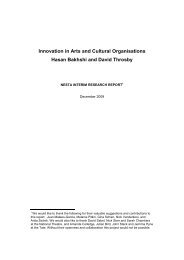Rumbling on performativity_Frits Simon
Rumbling on performativity_Frits Simon
Rumbling on performativity_Frits Simon
Create successful ePaper yourself
Turn your PDF publications into a flip-book with our unique Google optimized e-Paper software.
Auto-ethnography<br />
Auto-ethnography is already a l<strong>on</strong>gstanding traditi<strong>on</strong> – the term was coined in 1979<br />
– in which research from a reflexive and rather ‘pers<strong>on</strong>al’ perspective is d<strong>on</strong>e and in<br />
due course is being legitimized within the broader scientific community. Auto-ethnography<br />
is a rather eclectic research praxis (Learm<strong>on</strong>th and Humphreys, 2012). I will<br />
elaborate <strong>on</strong> what auto-ethnography is about and stipulate some differences within<br />
this approach. With this introducti<strong>on</strong> of auto-ethnography I also intend to introduce<br />
auto-ethnography in the Dutch scientific community, which to my knowledge, for a<br />
larger part is unfamiliar with this way of doing research.<br />
Textbox 6: An excursi<strong>on</strong> <strong>on</strong> auto-ethnography<br />
Given the amount of recently published overviews of auto-ethnographic research<br />
(Boylorn and Orbe, 2014a; Chang et al., 2013; Denzin, 2014; Holman J<strong>on</strong>es<br />
et al., 2013a) auto-ethnography is really coming of age.<br />
Auto-ethnography is radically reflexive. Reflexive narratives are written about<br />
for instance the experience of aborti<strong>on</strong>, mourning, depressi<strong>on</strong>, divorce, racism,<br />
finding <strong>on</strong>eself in a minority positi<strong>on</strong>, cultural and gender identities, and the<br />
whereabouts of working in public relati<strong>on</strong>s or science, or of being subjected to<br />
crime and healthcare. As an example I recapitulate a narrative about the way a<br />
recently appointed member of staff of a university was excluded by his colleagues.<br />
“They didn’t need to know him; they just disliked him. His different views of the<br />
subject, his brash dismissal of l<strong>on</strong>g-standing departmental texts, his absence at<br />
staff evening “b<strong>on</strong>ding” sessi<strong>on</strong>s, his challenging of time-h<strong>on</strong>ored pedagogical<br />
practices, his keeping himself to himself, his refusal to wear the standard issue<br />
shirt, his outsider-ness.” (J<strong>on</strong>es, 2011: 631) is the introducti<strong>on</strong> <strong>on</strong> a narrative is<br />
which the author makes transparent why a recently appointed member of staff<br />
resigns. After being criticized and isolated in meetings, in being ignored in the<br />
canteen and being judged as a danger to established hegem<strong>on</strong>y this member of<br />
staff resigns from <strong>on</strong>e day to the next. According to the author this exclusi<strong>on</strong> is<br />
not to be reduced to the acts of <strong>on</strong>e pers<strong>on</strong>, the management or some specific<br />
causes. This exclusi<strong>on</strong> evolves in a process of weeks in which some colleagues<br />
criticize or ignore the member of staff and in which some ignore the possibility<br />
to support their colleague. The auto-ethnographic narrative is a descripti<strong>on</strong><br />
from within of a micro-political process which has a not-managed but apparently<br />
desired outcome. At various moments the author w<strong>on</strong>ders about her own<br />
c<strong>on</strong>tributi<strong>on</strong>s to this process of exclusi<strong>on</strong> and what she might or needed to have<br />
d<strong>on</strong>e to stop this process. “Exclusi<strong>on</strong>” appears to be something which is enacted<br />
and not an abstract social mechanism.<br />
This narrative exemplifies that auto-ethnography is radical because it turns the<br />
reflexive act up<strong>on</strong> the researcher self to dec<strong>on</strong>struct his or her c<strong>on</strong>structi<strong>on</strong>s of<br />
reality (Cunliffe, 2003). Researchers who identify themselves with auto-ethno-<br />
40



